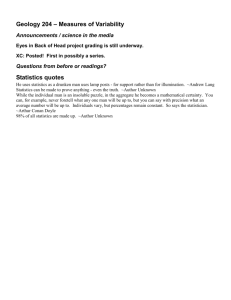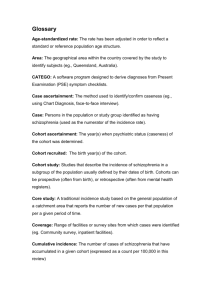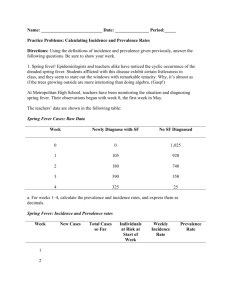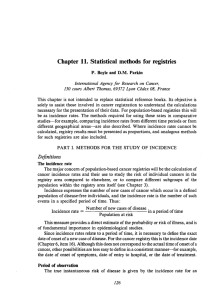癌症組_6 90年癌症登記簡要說明-英
advertisement
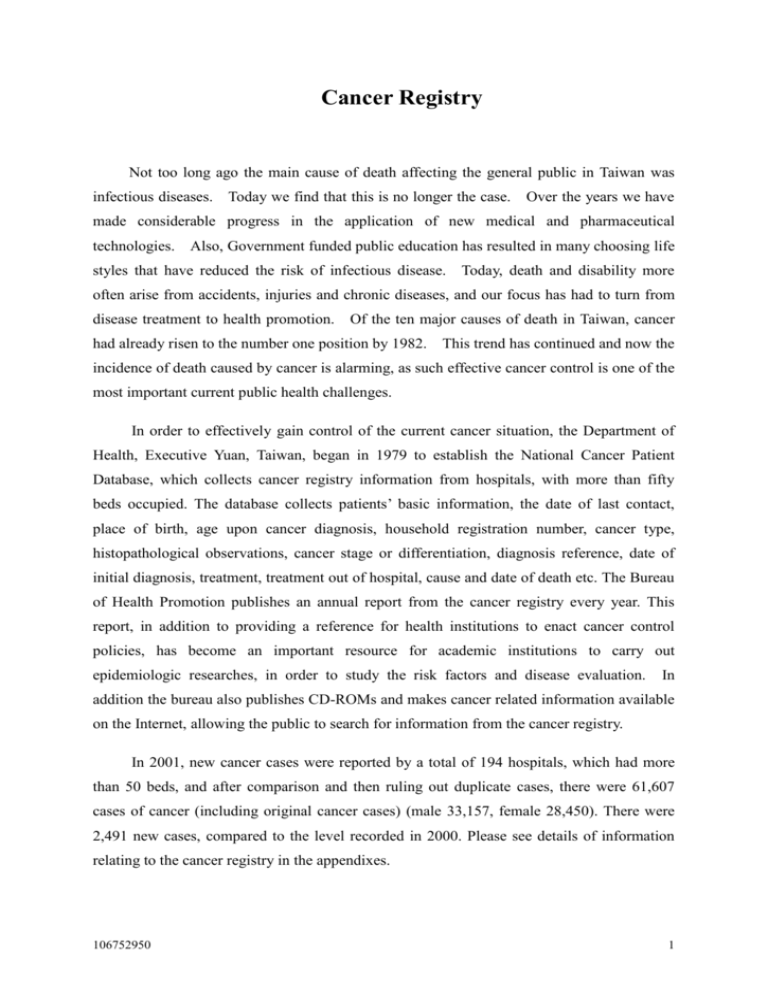
Cancer Registry Not too long ago the main cause of death affecting the general public in Taiwan was infectious diseases. Today we find that this is no longer the case. Over the years we have made considerable progress in the application of new medical and pharmaceutical technologies. Also, Government funded public education has resulted in many choosing life styles that have reduced the risk of infectious disease. Today, death and disability more often arise from accidents, injuries and chronic diseases, and our focus has had to turn from disease treatment to health promotion. Of the ten major causes of death in Taiwan, cancer had already risen to the number one position by 1982. This trend has continued and now the incidence of death caused by cancer is alarming, as such effective cancer control is one of the most important current public health challenges. In order to effectively gain control of the current cancer situation, the Department of Health, Executive Yuan, Taiwan, began in 1979 to establish the National Cancer Patient Database, which collects cancer registry information from hospitals, with more than fifty beds occupied. The database collects patients’ basic information, the date of last contact, place of birth, age upon cancer diagnosis, household registration number, cancer type, histopathological observations, cancer stage or differentiation, diagnosis reference, date of initial diagnosis, treatment, treatment out of hospital, cause and date of death etc. The Bureau of Health Promotion publishes an annual report from the cancer registry every year. This report, in addition to providing a reference for health institutions to enact cancer control policies, has become an important resource for academic institutions to carry out epidemiologic researches, in order to study the risk factors and disease evaluation. In addition the bureau also publishes CD-ROMs and makes cancer related information available on the Internet, allowing the public to search for information from the cancer registry. In 2001, new cancer cases were reported by a total of 194 hospitals, which had more than 50 beds, and after comparison and then ruling out duplicate cases, there were 61,607 cases of cancer (including original cancer cases) (male 33,157, female 28,450). There were 2,491 new cases, compared to the level recorded in 2000. Please see details of information relating to the cancer registry in the appendixes. 106752950 1 Appendix 2001 Cancer Registry Report 1. In 2001, new cancer cases were reported by a total of 194 hospitals, which had more than 50 beds, and after comparison and then screening out duplicates, there were 61,607 cases of cancer (including original cancer cases) (male 33,157, female 28,450). There were 2,491 new cases, compared to 2000. Moreover, after the data gained by cancer registration covered major symptoms and diseases as well as information on death in Taiwan, the completeness and accuracy reached 95% and 98.9% respectively. These are both are in line with the criteria (90%, 95%) set up by the North American Association of Central Cancer Registries. 2. The crude cancer incidence rate in 2001 was 274.96 per one hundred thousand populations, of which male and female came to 289.79 and 259.49 per one hundred thousand persons respectively. The total cancer age-standardized incidence rate is 261.13 per one hundred thousand persons, of which male and female are respectively 278.02 and 243.41 per one hundred thousand persons. The crude cancer incidence rate and cancer age-standardized incidence rate are higher than those in 2000 (See appendix 1). 3. In 2001, males most frequently suffered cancers of the five major organs: (1) Liver and bile duct; (2) Lungs, trachea and bronchus; (3) Colon and rectum; (4) Oral cavity (include mouth, pharynx and lower pharynx); and (5) Stomach. Females most frequently suffered the following cancers: (1) Cervical (include in situ carcinoma); (2) Breast; (3) Colon and rectal; (4) Liver and bile duct: (5) Lungs, trachea and bronchus (See appendix 2). 106752950 2 4. Males and females have different organs predisposed to the disease so their total cancer survival rates are different. The female five-year survival rate of total cancers (in situ carcinoma not included) is 57.84%, which is far higher than that of males, 32.35%. 5. Comparing the age-standardized incidence rate of cancers in recent five years (1997-2001), the rate of invasive cervical cancer declined the most dramatically (↓21.30%), indicating that early cervical smear testing is very effective. Other cancers that also have declined in age-standardized incidence rate include female gastric cancer (↓13.62%) and male nasopharyngeal carcinoma (↓6.56%). Cancers showing increases greater than 10% of the age-standardized incidence rate for males include those of the oral cavity (↑29.40%), esophagus (↑27.08%), skin (↑21.99%), prostate (↑20.84%), colon and rectum (↑16.31%), liver (↑15.14%) and bladder (↑13.29%). For females cancers showing similar increases include those of the womb (↑26.86%), breast (↑23.97%), liver (↑21.19%), skin (↑16.91%), lung (↑13.42%), colon and rectum (↑12.34%) and. thyroid adenoma (↑22.96%). To improve the completeness and accuracy of cancer registry data, the Bureau of Health Promotion, Department of Health, launched the following measures in 2004: (1) Serious symptoms or diseased case files are to be forwarded to hospitals, which are required to confirm and report cases for cancer registry; because of this, the comprehensive nature of registry data has increased from 85% in 1996 to 95% in 2001; (2) Four basic staff training sessions on the cancer registry have been held to train cancer registry staff to a high level in order to increase the quality of the cancer registry. The first examination for qualifications for cancer registry staff were held on 19 December 2004 (to register for the examination, please see information online: http://w3.sce.pccu.edu.tw/health), which has been included in hospital evaluations in 2005; (3) Case histories should be re-checked to increase the accuracy of the data reported. Aware of the threat of cancer to the citizens of Taiwan, the government announced cancer prevention regulations on 21 May 2003. This was in order to integrate resources of medical treatment and health prevention, and effectively carry out the work of cancer prevention. A five-year cancer prevention plan has been drawn up for approval by the Executive Yuan, Taiwan, in the hope of lowering the death rate from cancer in Taiwan. Currently, the five-year cancer prevention plan drawn up by the Department of Health is mainly concerned with: (1) Creation of an integrated cancer prevention framework, 106752950 3 (2) Encouragement of a healthy life style for people to lower their risk factors for various cancers, (3) Carrying out cancer screening for early diagnosis and treatment, (4) Establishing the practice of cancer management in hospitals to ensure the quality of diagnosis and treatment, (5) Actively carrying out gentle and moderate treatment to increase patients’ quality of life, (6) Establishing a cancer prevention database and continuously monitoring and evaluating the cancer prevention plan, (7) Integrating and performing relevant cancer research, and (8) Professional training. 106752950 4 Appendix 1: Comparison of 2000 and 2001 Cancer Occurrence Information 2001 Year Item Male 2000 Female Male Female Case Number (patient) Age Mediam Number Crude Incidence Rate (105) Age-standardized incidence rate (105) Gender Ratio Appendix 2-1: The Incidence Rate of Ten Major Cancer in 2001 Increase or decrease of Age-Standardized Crude Incidence Rate Age-Standardized Age-Standardized Incidence between 2001 and Incidence Rate Incidence Rate Rate 2000 (%) 2001 Cancer Position Case Number 2000 Cervical Cancer In Situ Carcinoma Invasive Cancer Female Breast Liver and Bile Duct Colon and Rectum Lungs, trachea and bronchus Prostate Gland Oral Cavity (mouth, pharynx and lower pharynx) Stomach Skin Bladder Other Positions Total Note 1: World standard population in 2000 is used as the standard population in the calculation of age-standardized incidence rate. Note 2: Percentage of increase or decrease = (year 2001 age-standardized incidence rate – year 2000 age-standardized incidence rate)/ year 2000 age-standardized incidence rate Note 3: The unit is per one hundred thousand populations 106752950 5 Appendix 2: The Incidence Rate of Male Ten Major Cancers in Taiwan in 2001 Increase or decrease of Age-Standardized Crude Incidence Rate Age-Standardized Age-Standardized Incidence between 2001 and Incidence Rate Incidence Rate Rate 2000 (%) 2001 Cancer Position Case Number 2000 Liver and Bile Duct Lungs, trachea and bronchus Colon and Rectum Oral Cavity (mouth, pharynx and lower pharynx) Stomach Prostate Gland Bladder esophagus Skin Nose and Pharynx Other Positions Total 106752950 6 Appendix 203: The Incidence Rate of Female Ten Major Cancers in Taiwan in 2001 2001 Cancer Position Case Number Crude Age-Standardized Incidence Incidence Rate Rate 2000 Case Number Increase or decrease of Age-Standardized Incidence Rate between 2001 and 2000 (%) Cervical Cancer In Situ Carcinoma Invasive Cancer Female Breast Colon and Rectum Liver and Bile Duct Lungs, Trachea and Bronchus Stomach Skin Thyroid gland Ovary, Fallopian tube and Wide Ligament Womb Other Positions Total Note 1: World standard population in 2000 is used as the standard population in the calculation of age-standardized incidence rate. Note 2: Percentage of increase or decrease = (year 2001 age-standardized incidence rate – year 2000 age-standardized incidence rate)/ year 2000 age-standardized incidence rate Note 3: The unit is per one hundred thousand populations 106752950 7

